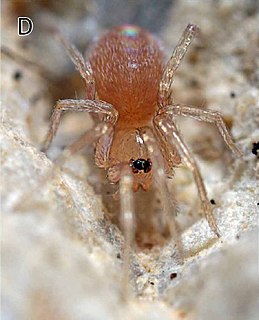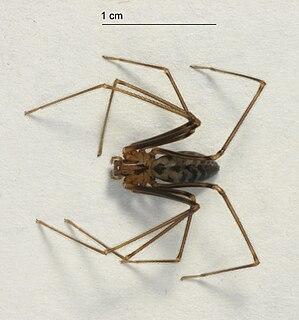
Oonopidae, also known as goblin spiders, is a family of spiders consisting of over 1,600 described species in about 113 genera worldwide, with total species diversity estimated at 2000 to 2500 species. The type genus of the family is OonopsKeyserling, 1835.

Drymusa is a genus of false violin spiders that was first described by Eugène Simon in 1892. They physically resemble violin spiders (Loxosceles), but their bites are not believed to be medically significant. Originally placed with the spitting spiders, it was moved to the Loxoscelidae in 1981, then to the Drymusidae in 1986.

Orsolobidae is a six-eyed spider family with about 180 described species in thirty genera. It was first described by J. A. L. Cooke in 1965, and was raised to family status from "Dysderidae" in 1985.

Unicorn ("one horn", in Latin) is a genus of goblin spiders from South America, containing seven species that occur predominantly in high elevation, semi-desert regions of Bolivia, Chile, and Argentina. Individuals are relatively large for goblin spiders, measuring up to 3.0 mm (0.12 in) in body length. The genus name refers to a characteristic pointed projection between the eyes and jaws of males. In at least one species, broken-off tips of the male pedipalps have been found within the genitalia of females, postulated as a means of sperm competition. Unicorn possesses several traits that suggest it is a relatively "primitive" member of the Oonopidae, and is classified with other similar, soft-bodied goblin spiders in the subfamily Sulsulinae.
Antônio Domingos Brescovit is a Brazilian arachnologist. His first name, Antônio may also be spelt António. He develops academic activities at the 'arthropodae laboratorium' at the Butantan Institute, and he is a specialist in Neotropical Arachnida.

Caponiidae is a family of ecribellate haplogyne spiders that are unusual in a number of ways. They differ from other spiders in lacking book lungs and having the posterior median spinnerets anteriorly displaced to form a transverse row with the anterior lateral spinnerets. Most species have only two eyes, which is also unusual among spiders. A few species of Caponiidae variously have four, six or eight eyes. In some species the number of eyes will increase when the spiderling changes its skin as it grows towards adulthood.
Predatoroonops is a genus of goblin spiders endemic to the Brazilian Atlantic Forest. The genus is characterized by the extremely modified male chelicerae and long pairs of ventral spines. It is the first fully revised endemic Brazilian genus of spiders, uncovered in 2012 after two and a half years of research at São Paulo's Instituto Butantan.
Guaraguaoonops is a genus of spiders in the family Oonopidae. It was first described in 2012 by Brescovit, Rheims & Bonaldo. As of 2016, it contains 2 species, both from Brazil.
Neoxyphinus is a genus of spiders in the family Oonopidae. It was first described in 1953 by Birabén. As of 2017, it contains 48 species.
Prodysderina is a genus of spiders in the family Oonopidae. It was first described in 2013 by Platnick et al.. As of 2017, it contains 9 species.
Pseudodysderina is a genus of spiders in the family Oonopidae. It was first described in 2013 by Platnick, Berniker & Bonaldo. As of 2017, it contains 8 species, all found in South America.
Tinadysderina is a genus of spiders in the family Oonopidae. It was first described in 2013 by Platnick, Berniker & Bonaldo. As of 2017, it contains 6 species from Colombia and Ecuador.
Otiothops is a genus of palp-footed spiders that was first described by W. S. MacLeay in 1839.

Strotarchus is a genus of araneomorph spiders in the family Cheiracanthiidae that was first described by Eugène Louis Simon in 1888. Originally added to the Clubionidae, it was moved to the Miturgidae in 1967, and to the Cheiracanthiidae in 2014. It is considered a senior synonym of Marcellina and Coreidon.
Amazoonops is a genus of spiders in the family Oonopidae. It was first described in 2017 by Ott, Ruiz, Brescovit & Bonaldo. As of 2017, it contains 5 species, all from Brazil.
Coxapopha carinata is a species of araneomorphae spider of the family Oonopidae.
Medionops is a genus of araneomorph spiders in the family Caponiidae, first described by A. Sánchez-Ruiz & Antônio Domingos Brescovit in 2017.





